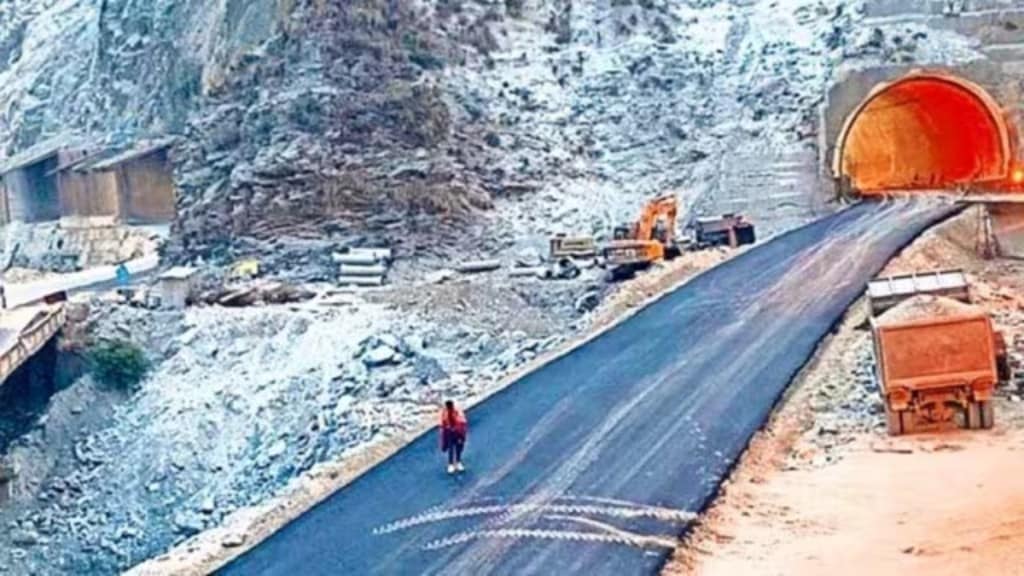In the coming few weeks, the Border Road Organisation (BRO) will be completing certain infrastructure projects along the China border, including some road patches on an alternate route to Leh which ensures an all-weather connectivity, The Indian Express said.
The BRO has also prioritised specific projects under the India-China Border Roads program, focusing on achieving full connectivity to the Lipulekh Pass on the Mansarovar Yatra route in Uttarakhand.
What projects is the BRO working on?
According to senior officials familiar with the matter, the BRO’s immediate priorities include connecting a 4-kilometer uncut section of the Nimu-Padam-Darcha road and beginning construction on the 4.1-kilometer twin-tube Shinku La tunnel on the Manali-Darcha-Padam-Nimu axis.
The work on the uncut part of Nimu-Padam-Darcha road is nearing completion and a majority of the road has already been blacktopped. The remaining work is expected to be completed in the coming weeks.
According to officials, establishing connectivity to a road running parallel to the Line of Actual Control (LAC) in eastern Ladakh is also a key priority for the BRO.
In addition to the existing 255 km Durbuk-Shyok-Daulat Beg Oldie (DS-DBO) road, two other roads run parallel to the LAC at different locations. One connects Leh to Demchok via Karu and Nyoma, while the other links Durbuk to Nyoma via Chushul, south of Pangong Tso lake.
An official stated that establishing connectivity to the Leh-Demchok road in eastern Ladakh has been prioritised, with much of the construction work already completed. There are plans to eventually upgrade these roads to double lanes.
Shinkun La Tunnel project
The full-fledged construction work of Shinkun La Tunnel project, which is set to be the world’s highest tunnel at 15,800 feet, is set to commence in the upcoming weeks, officials revealed.
The tunnel, to be constructed at a cost of ₹1,681 crore, will reduce the distance between Manali and Leh by 60 km. It will also connect the 4 km uncut section of the Nimu-Padam-Darcha road, providing the third all-weather route to Leh as an alternative to the two older routes.
Currently, there are three routes to reach Leh, including the Srinagar-ZojiLa-Kargil route in J&K. Another route passes through Manali-Rohtang in Himachal Pradesh. This road divides at a location called Darcha, with one route leading to Leh via Padam and Nimu, while the other crosses the Baralacha La pass in Himachal Pradesh and Tanglang La in Ladakh via Karu before reaching Leh. However, neither of these routes offers all-weather connectivity at present. The Srinagar-Leh and Baralacha La-Karu-Leh routes are the traditional paths to reach Leh.
Four roads, lying in Arunachal Pradesh, have been listed by the BRO seeking completion under the first two phases of the ICBR project. These projects include three roads totaling 330.95 km and another road at Surwa Samba, the last border post on the India-China border near Zemithang, under the second phase of the ICBR.
The BRO is required to submit detailed project reports for 14 roads totaling 320.71 kilometre under the ICBR Phase III. These projects include essential link roads to the LAC in eastern Ladakh, such as the road connecting Chushul-Lukung to Thakung, the DS-DBO road track junction, and the Gapshan to DS-DBO road. Additionally, they encompass border roads in Arunachal Pradesh, including the Tuting-Murbo-Bane route and the Bishing-Tinali area, among others
The agency is prioritising the construction of the 2.79 km Sungal tunnel on the Akhnoor-Poonch National Highway in Jammu and Kashmir, as well as achieving full connectivity to the Lipulekh Pass on the Mansarovar Yatra road, which lies on the India-China border.
The breakthrough blast for the Sungal tunnel on National Highway 144A was completed in May this year. According to the BRO, this blast marks the end of excavation for the tunnel, which will streamline travel through hill sections and reduce both time and distance to reach Rajouri and Poonch upon its completion.

